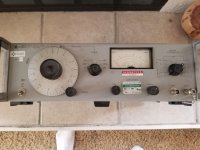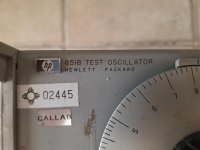Hi All, after years of building audio stuff I decided I was going to learn how to test it before I blew speakers 
I have a good soldering iron, two good Oscopes, an old electronics workbench from Los Alamos, a Veriac, drawers of hand tools.
What else do I need.....like signal generator and such.
I am just now setting up my audio room after moving from Michigan to Albuquerque and have 3 amp projects and one active tube crossover project that I'd like to get on.
I have a good soldering iron, two good Oscopes, an old electronics workbench from Los Alamos, a Veriac, drawers of hand tools.
What else do I need.....like signal generator and such.
I am just now setting up my audio room after moving from Michigan to Albuquerque and have 3 amp projects and one active tube crossover project that I'd like to get on.
Hi DJN- at least one multimeter, a signal generator, 4 and 8 ohm load resistors. A distortion analyzer and tube tester are nice tools to have. There are PC based signal generators, analyzers available, but I'm old and old school, so I prefer analog meters. Make sure that Los Alamos bench doesn't glow at night. 
A bunch of high voltage, ideally silicone leads with various terminations to make life quicker.
If possible a differential probe for the scope would be a godsend, I wish I had one.
I find at least two multimeters essential, so I can measure how two variables play out at the same time.
Whilst spending your money I also wish I had an IR remote thermometer, one of those things with a screen so you can see component temperatures. I have never used one but imagine its handy for reduction of magic smoke.
If possible a differential probe for the scope would be a godsend, I wish I had one.
I find at least two multimeters essential, so I can measure how two variables play out at the same time.
Whilst spending your money I also wish I had an IR remote thermometer, one of those things with a screen so you can see component temperatures. I have never used one but imagine its handy for reduction of magic smoke.
If possible a differential probe for the scope would be a godsend, I wish I had one.
Here's a DIY probe that works well enough for many purposes.
Attachments
Whilst spending your money I also wish I had an IR remote thermometer, one of those things with a screen so you can see component temperatures. I have never used one but imagine its handy for reduction of magic smoke.
One of the best things I have bought.
Instead of burning my fingers checking temperatures I can point my laser at it and read off the screen.
Adequate Lighting.
Which may or may not be achieved through using LED light sources. I am not very familiar with the latest in LED lighting, but I have yet to find any I liked.
OSHA standards seem to recommend a level of 50 to 100 candle power for fine work, and arraigned to avoid glare.
What works for my bench is a series of Halogen "Jewelry Case" 12 volt/20 watt lamps with integrated reflectors, mounted about 22" above the work surface and about 16" apart. Each lamp is on/off switchable and can be fully dimmed. The dimming circuit is comprised of a small ~2.5 amp variac supplying the primary of a transformer with a ~13.8 volt, 8 amp secondary.
This arraignment provides for the exact amount of light needed at the time, has excellent color rendition, and no eye strain. The MR-16 lamps, which used to be fairly expensive, are now available at low cost as surplus from vendors such as All Electronics.
I hope this may be of some help. This is a custom, adaptable and scalable bench lighting solution which can be built at a very low cost. Also does not emit any discernable RFI, which cannot be broadly claimed for the gaggles of cheap light fixtures sold of late.
MR-16 Halogen Lamps | All Electronics Corp.
Regards, -DAAB-
Which may or may not be achieved through using LED light sources. I am not very familiar with the latest in LED lighting, but I have yet to find any I liked.
OSHA standards seem to recommend a level of 50 to 100 candle power for fine work, and arraigned to avoid glare.
What works for my bench is a series of Halogen "Jewelry Case" 12 volt/20 watt lamps with integrated reflectors, mounted about 22" above the work surface and about 16" apart. Each lamp is on/off switchable and can be fully dimmed. The dimming circuit is comprised of a small ~2.5 amp variac supplying the primary of a transformer with a ~13.8 volt, 8 amp secondary.
This arraignment provides for the exact amount of light needed at the time, has excellent color rendition, and no eye strain. The MR-16 lamps, which used to be fairly expensive, are now available at low cost as surplus from vendors such as All Electronics.
I hope this may be of some help. This is a custom, adaptable and scalable bench lighting solution which can be built at a very low cost. Also does not emit any discernable RFI, which cannot be broadly claimed for the gaggles of cheap light fixtures sold of late.
MR-16 Halogen Lamps | All Electronics Corp.
Regards, -DAAB-
I found this Hewlett Packard 608e V.H.F signal generator for
a good price. Would it work for my amps?
That generator starts at 10MHz.
http://hparchive.com/Manuals/HP-608E-608F-Manual.pdf
Ah, so looking for stuff that works under 40khz? I'm also seeing a lot
of power supplies. What volt and amps would be good. My current amp project
tube heater takes 20v and 3A each tube.
A typical supply would have 30-50VDC at 3-5A. I would get either two singles, or a dual with
tracking and strapping options for series or parallel. Current limiting is a good feature to have.
The filament supply could be a laptop switcher.
HLG-60H-20A: MEAN WELL : 20V 3A 60W Class 2 Enclosed Switching Power Supply Outputs Adjustable by Internal Pot : Power Supplies & Wall Adapters
Last edited:
I went to his place and got this for 5 bucks and a 3 hour
lesson on how most of this stuff works.
I used to have one of those, it's old school, but ok.
Good enough for troubleshooting and general testing.
One of the best things I have bought.
Instead of burning my fingers checking temperatures I can point my laser at it and read off the screen.
I took it a step further and have an infrared camera now. I won’t claim they are cheap but can build one on a raspberry pi.
For the OP, I second the power supply suggestion...with current and volt limiting. A couple are nice so component power and signal voltages can be set without fiddling around. Lots of options out there on cheapish imports.
I sort of laugh at myself for the things I used to do to get DC power...and now I just flip a switch and turn a knob or two.
Last edited:
I have been using the LED strip lights (like they sell for kitchens) under the lowest shelf on my bench for several years. They have worked OK but not really enough light. Recently I was lucky enough to get some high bay type lighting (like you find in a big box retailer), all LED, however they are expensive and I'm now using 500W worth of LED lighting in the shop. I can see everything but its really too much. I get between 600 and 1500 lux in the shop. For working on the latest fine pitch stuff it seems essential. I would target that light level at a working location (similar to surgical work). FWIW my phone using GPSstatus reads almost the same as my luxmeter. I am also convinced I needed a lot less light 30 years ago to do the same work. Also be sure to arrange the lighting so you are not in the way of your lighting.
I find an LED angle poise lamp best for electronic bench work.
It sits just a few inches above the pcb I am working on and puts out loads of light.
The room has a very bright LED mains lamp anyway so that helps.
The only problem with the LED angle poise lamp is the radiation from it sometimes gets into a pcb and interferes with signals.
It sits just a few inches above the pcb I am working on and puts out loads of light.
The room has a very bright LED mains lamp anyway so that helps.
The only problem with the LED angle poise lamp is the radiation from it sometimes gets into a pcb and interferes with signals.
- Status
- This old topic is closed. If you want to reopen this topic, contact a moderator using the "Report Post" button.
- Home
- Design & Build
- Equipment & Tools
- need help with new workbench

